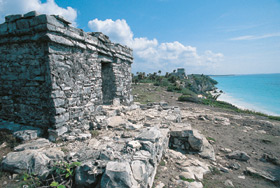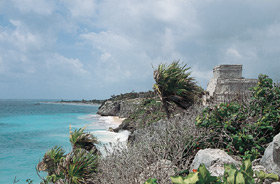|
Featured
Article
Hidden
Secrets of the Riviera Maya
Story
and Photographs by Dan Millington
I've
been covering Mexico for seven years, and I never
seem to tire of it. I've been to Cancœn many times
and often wondered what mysteries lie south in places
like Tulum, Coba, Pac Chen, Akumal, Xel-Ha and Muyil.
I thought it was time to dig a little deeper and find
out what this area of the Maya world really had to offer.
After some research on the Web, I decided that Tulum
would be the first stop and I chose Ana Y Jose Restaurant
Bar & Caba-as for the first couple nights' lodging.
I don't know why, it just felt right. I was in for a
pleasant surprise. From Tulum, I worked my way north.
I booked a flight on Aero Mexico, which has direct flights
out of Los Angeles, and flew into Cancœn. Upon
arrival, the first thing on my agenda was to get out
of the Cancœn airport without paying a fortune
in taxi fares. An important thing to know about obtaining
transportation from the Cancœn airport is that
no price is set in stone, particularly with cabbies.
My objective was to nail down a collectivo (Chevy Suburban)
that was going to Playa del Carmen with other tourists
and negotiate a reasonable price. I found one just outside
the terminal and managed to arrange a fare of 15 U.S.
dollars.
Playa del Carmen is situated just inland on the Mexican
Caribbean, about 40 minutes south of the Cancœn
airport along highway 307. From there I rented a car
and continued my journey south to Tulum.
Once in Playa del Carmen, I found Budget Rent-a-Car
and managed to negotiate an open-air jeep for 30 U.S.
dollars per day, being that early May is considered
out-of-season. I paid about half of what it would have
cost at the airport. This out of the way, my Maya journey
was about to begin.
The newly paved road from Cancœn through Playa
del Carmen to Tulum, Mexico 307, is in great shape.
It is a straight 30-minute drive from Playa del Carmen
to Tulum. About five miles before arriving at the town
of Tulum, I was looking for a sign along the highway
that said, Coba. Instead of turning right to "Coba,"
I turned left and followed the road until its end and
turned right. I was now heading for what's known as
Tulum's hotel zone, an exquisite area of small hotels
on the Mexican Caribbean.
I didn't know what to expect when I arrived to Ana y
Jose Hotel, but I do remember feeling a wonderful sense
of tranquility. "This was nothing like Cancœn,"
I thought. Hugo Solis, the hotel's manager, was there
to greet me. "Welcome to Tulum, Mr. Millington.
We have your room ready." Room eight, upstairs
(of which there are only 15), over-looking the pool,
gently breezing palms and the talcum-powdered beach.
The room was decorated in bright Mexican colors with
two double beds and an open-air palapa roof. I immediately
felt the warm Caribbean winds flowing through me. The
first order of business was to open my suitcase and
take out one thing, my bathing suit. I have never undressed
so fast (except for love-making) to get to where I wanted
to go-the turquoise, crystal-clear, 75-degree Caribbean
ocean. The plan: to lie in it for hours.
That
night, Hugo invited me for dinner in the hotel's restaurant,
a large, palapa structure with a sand floor and cool
ocean breezes that relaxed the heat of the day. I ordered
the fresh, whole-fried snapper with sautŽed julienne
vegetables and a curiously seasoned bed of rice. The
fish fell off the bone and melted in my mouth. I imagined
some weathered, old Mexican fisherman bringing in the
catch just hours before, still wiggling with life.
During dinner, I asked Hugo, "I would like to visit
Pac Chen and Coba. Can I do this on my own?" "Coba
you can, sorry, Pac Chen you can't," Hugo said.
It turned out that the Mayan village of Pac Chen had
recently opened its doors to a limited amount of tourists
after hundreds of years of isolation. Only one company
was allowed to take visitors in, Alltournative Tours.
The elders of the village had voted for this company
because of the respect they had for their culture and
their environment. "Can you arrange a tour for
me?" I asked Hugo. "Sure, when would you like
to go?" "Would day after tomorrow be okay?"
I replied. "Done," he said. I was to be ready
at 9:00 am.
First on my agenda the next day was the archaeological
site of Tulum and the fresh-water lagoons of the park,
Xel-Ha. Tulum, (Maya for The Wall), located about four
miles north of Tulum's hotel zone, dates back to the
Post-Classic period (A.D. 1200-1524). The Mayans there
some 900 years ago must have been visionaries. They
realized the value of oceanfront property.
I had heard this was the most visited site in the Maya
world, so I arrived early to avoid the crowds. At first
glance, I was somewhat dismayed at how many kitschy
shops surrounded the area where you hop a tram for the
short ride to the site. Once there, guides are available
to escort you through the ruins along with an explanation
of its history. I chose to go this one on my own. Notice
this is the first time I have said ruins. Why? Because
that is exactly what the site is. Ruined. The most imposing
building, El Castillo (The Castle) overlooking the Caribbean,
was the highlight for me. However it was roped off to
prevent a closer inspection. Temple of the Frescos with
interior murals that display typical Maya motifs was
interesting. But that was about it for me. I guess I'm
somewhat jaded after having been to such sites as Edzna
and Palenque. "Perhaps Coba would be different,"
I thought.
After about a half-hour walk through Tulum photographing
every Iguana I could find, I began to see more and more
people arrive; hundreds, in fact. It was time to make
my exit. I was thinking on my way out that the site
of Tulum is definitely worth a first-time visit; however,
a short visit and a very early visit, then on to Xel-Ha.
Xel-Ha (Maya for place where the water is born) is located
several miles north of the archaeological site of Tulum.
There is no way I could have missed the entrance. The
sign Xel-Ha, along highway 307, is clearly indicated
and massive. For all intent and purposes, this is an
aquatic theme park, but a nice one. This is where spring-fed
inland rivers, cenotes, caves, jungle flora and fauna
intertwine in a symbiotic relationship with the Caribbean
ocean. The owners, Grupo Xcaret, have gone out of their
way so as not to spoil this natural wonder.
At the park's entrance, I decided to splurge and pay
the full price, $45 U.S. What I got was this: a locker,
a towel, snorkel gear, a wristband indicating I could
eat at any of the four restaurants at any time, an inner-
tube, and environmently friendly sun-block. The latter
took quite a bit of scrubbing to remove. Once inside,
I located a path that would lead me to the locker room.
On my right were exotically colored parrots and on my
left, the beginning of the translucent lagoons. Suddenly,
to my surprise, five dolphins leaped out of the water
and performed an acrobatic display. Normally, I'm opposed
to the captivity of these animals, but here, it seemed
different. Here they have the room they need to swim
and it appears they're content. Another high mark for
the owners of Xel-Ha.
I determined that the best way to explore the park was
to let my inner tube take me wherever the currents flowed.
At first glance, I was amazed at the variety of the
tropically colored marine life. "A rainbow can't
hold a candle to this," I thought. Secondly, the
clarity and color of the water, emerald green, and underwater
views that seemed endless. I floated by mangroves, caves,
inlets and dense jungle. I lost myself and all time
seemed forgotten. For what could have been hours or
days, I'm not sure, my sense of time returned and I
began to make my way back. Time for a quick shower and
a late buffet lunch.
The drive back to my hotel produced feelings of bliss
and contentment. "God, I'm lucky," I thought.
What I didn't realize was just how lucky I was going
to get.
That evening, I asked Hugo if there was another restaurant
nearby that I could experience. "Zamas," he
said. "Just down the road. You can walk there."
The moon, like an overhead diamond jewel, was full,
illuminating the sky and all my surroundings. During
my walk to Zamas, I had the distinct feeling I was being
followed. Not by a person, but by spirits, Maya spirits.
It was as if they were saying, "Welcome, welcome
to our world." What I was about to realize was
just how spiritual this area of the world really was.
(story
featured in South
Coast Magazine)
© Copyright 2004 South Coast Magazine.
No unauthorized duplication without written consent.
|



![]()


